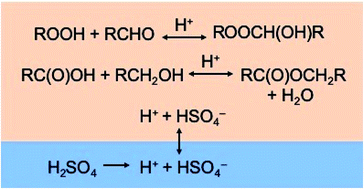Kinetics of oligomer-forming reactions involving the major functional groups present in atmospheric secondary organic aerosol particles†
Abstract
Atmospheric organic aerosol particles impact climate as well as human and environmental health. Secondary organic aerosol (SOA), which is formed by the gas-to-particle partitioning of products of the oxidation of volatile organic compounds (VOCs) emitted from biogenic or anthropogenic sources, contributes a large fraction of this material. In the particle phase, these products can undergo accretion reactions to form oligomers that impact the formation, composition, and chemical–physical properties of aerosols. While these reactions are known to occur in the atmosphere, data and models describing their kinetics and equilibria are sparse. Here, reactions of compounds containing potentially reactive hydroperoxide, hydroxyl, carboxyl, aldehyde, and ketone groups were investigated in single and phase-separated organic/aqueous mixtures in the absence and presence of a sulfuric acid catalyst. Compounds containing these groups and a nonreactive UV-absorbing nitrate group were synthesized and their reactions and products were monitored and characterized using high-performance liquid chromatography with UV detection (HPLC-UV), electrospray ionization-mass spectrometry (ESI-MS), and attenuated total reflectance-Fourier transform infrared (ATR-FTIR) spectroscopy. Reactions were observed between hydroperoxides and aldehydes to form peroxyhemiacetals, and between carboxylic acids and alcohols to form esters, and their rate and equilibrium constants were determined. No reactions were observed in other mixtures, indicating that under the conditions of these experiments only a few reaction pathways form oligomers. Reactions were also conducted with probe compounds and SOA formed in an environmental chamber reaction of α-pinene with O3. Whereas in a previous study we observed a rapid hydroperoxide reaction in this SOA, among the other compounds studied here only alcohols reacted. These results provide insight into the types of accretion reactions that are likely to occur in atmospheric aerosols, and the rate and equilibrium constants can be used to better model SOA chemistry.

- This article is part of the themed collections: Environmental Science: Processes & Impacts Recent HOT Articles, Atmospheric chemistry and Chemistry of Atmospheric Pollutants


 Please wait while we load your content...
Please wait while we load your content...
